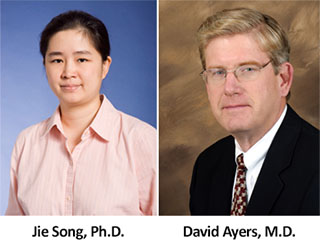


Posted December 16, 2014
Jie Song, Ph.D., University of Massachusetts Medical School
 Battlefield traumatic long bone injuries are often accompanied with infections and loss of periosteal membrane tissue. Because the periosteal membrane, which surrounds the bone, is an essential source of stem/progenitor cells and signaling molecules needed for effective bone healing, there is a high failure rate of bone graft-mediated repair of such injuries.
Battlefield traumatic long bone injuries are often accompanied with infections and loss of periosteal membrane tissue. Because the periosteal membrane, which surrounds the bone, is an essential source of stem/progenitor cells and signaling molecules needed for effective bone healing, there is a high failure rate of bone graft-mediated repair of such injuries.
With funding from a Fiscal Year 2009 (FY09) Peer Reviewed Orthopaedic Research Program (PRORP) Idea Development Award, tissue engineer Dr. Jie Song sought to develop an off-the-shelf, synthetic periosteal membrane that could promote graft healing in a manner similar to natural periosteal tissue. First, Dr. Song and her interdisciplinary team prepared and characterized the structural template of the pseudo-periosteum (PP). After conducting a series of tests and identifying the optimal chemical modification and thermal/mechanical annealing conditions, Dr. Song's team created hydroxyapatite-mineralized fiber meshes from either cellulose or degradable polymers that exhibited both high elasticity and high tensile strength. Second, the group characterized the cellular and biochemical properties of the synthetic PP in vitro. The mesh composites were shown to support potent osteogenic differentiation of bone marrow stromal cells. Using a critical-sized rat femoral segmental defect model, the composite fiber mesh was evaluated for its ability to promote allograft healing. By the end of the period of performance, Dr. Song's team had successfully developed the fibrous synthetic membranes, in both degradable and non-degradable formats, with elasticity and aqueous wettability that make them easy to be loaded with therapeutics or cells and wrapped around grafts.
Working with orthopaedic surgeon Dr. David Ayers, the Song laboratory demonstrated that the degradable synthetic fibrous membrane supported successful scaffold-guided regeneration of a long bone defect in rats. Currently, the team is seeking funding support to demonstrate broadened use of this material platform for skeletal tissue regeneration and to carry out preclinical feasibility studies using relevant large animal models to further establish the efficacy and long-term safety of their technology.
Links:














